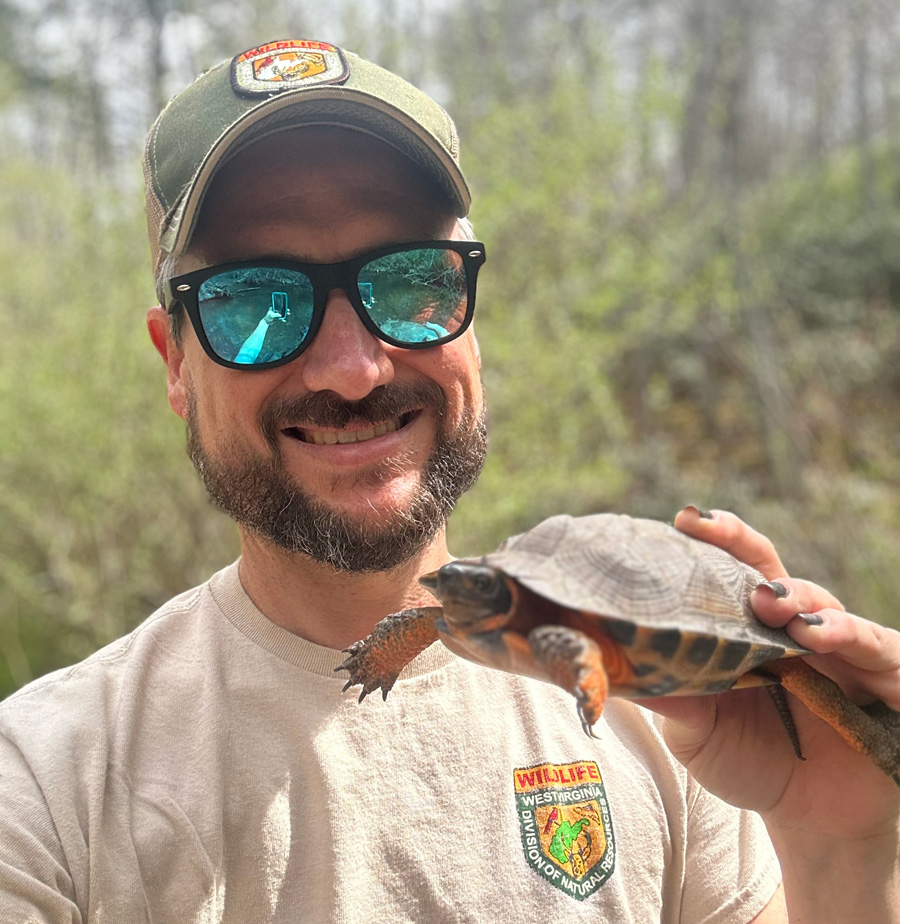Paddlers on the Cacapon River occasionally enjoy sharing their adventure with Common Merganser ducks and their fuzzy little babies splashing about the river. Or one of the many other families of ducks and geese that visit the unique 680-square-mile watershed.
More often, kayakers and canoers spy turtles stacked along a log basking in the sun or snakes soaking up the warmth of the rocks about the water. Many reptiles, amphibians, and other critters enjoy the bounty of the Cacapon River community.
“We have a nice diversity of turtles that occur in the Cacapon River,” said Kevin Oxenrider, West Virginia Division of Natural Resources (WVDNR) Amphibian and Reptile Program Leader. “There are eastern painted turtles, snapping turtles, red-bellied turtles, eastern musk turtles and a few other rare turtle species.”
“We also have box turtles in the riparian zones of the river,” Kevin adds. “We occasionally find them in the river, too, and they can swim!” Box turtles will wander into the river to cool off like summertime kayakers.
Diverse amphibian and reptile communities are good indicators of a healthy river environment. Amphibians, with their skin being so permeable, are more susceptible to toxins or pollutants that might be introduced into a water ecosystem—the canary in the coal mine for a change in conditions.
“The health of the Cacapon River watershed is so important in supporting the biodiversity in the state,” Kevin said proudly. “It’s home to rarer species like the upland chorus frog and northern cricket frog.” The wood turtle is one of the reptiles that also enjoys this wonderful watershed.
Sadly, people collecting these animals, especially several species of turtles, has played a major role in their decline in West Virginia. Fortunately, the WVDNR passed new regulations in 2021, making it unlawful to take or possess most native reptiles and amphibians in the state for any reason.
“We have a lot of good habitat which you don’t see much outside of West Virginia,” Kevin explained. “So we have pretty high responsibility to make sure we maintain those areas to keep the turtles and other wildlife here and throughout their range.” The Cacapon River flows mostly through forested land, lending itself to a more vibrant system to support healthy, diverse amphibian and reptile populations.
“There is a sense of pride for us to be good stewards for these animals and of the waterways like the Cacapon,” Kevin said. “It is important for them, and future generations hoping to see them.”
However, there are threats to their habitat.
Development pressure has increased in the eastern panhandle and is significant along the Cacapon River and its tributaries, with substantial residential and second-home development. Fragmenting large tracts of forests increases surface water temperatures and stormwater runoff.
“WVDNR has developed a Conservation Focus Area plan for the Cacapon River with actions to offset these threats,” Kevin explained. “Protecting the river will take voluntary actions from landowners, public agencies, and partner organizations, with support from the WVDNR.
The plan involves establishing or restoring riparian buffers, including streamside fencing, to reduce sedimentation and nutrient runoff; land conservation to relieve development pressures; and encouraging landowners to maintain large forest blocks with forest management plans to protect diverse habitats. Folks can read the plan on the WVDNR website.”
Helping preserve and protect the Cacapon River watershed, Kevin is leading conservation and research efforts for WV’s diverse array of amphibians and reptiles. Alongside his regional, national, and international colleagues, his work is focused on protecting all these animals. Although, he has a few favorites.
“I gravitate towards my turtles. The spotted turtle. The wood turtle,” Kevin laughs. “I love the musk turtle. I love how adorable they look. They look so pudgy, like angry, grumpy old people. I love them.”
Peter Wood is a board member of the Friends of the Cacapon River, whose mission is to preserve, protect, and promote the environmental health and scenic character of the Cacapon River and its watershed.
Photos: Kevin Oxenrider, WVDNR Amphibian and Reptile Program Leader, holds turtles close to his heart.

